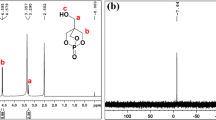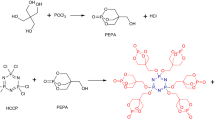Abstract
In this study, a Schiff base 2,4,6-tris(4-hidroksibenzimino)-1,3,5-triazine (HT) was synthesized from condensation reaction of 4-hydroxybenzaldehyde and melamine. Subsequently, various imine or ether bond cage polymers were synthesized using 2,4,6-tris(4-hydroxybenzimino)-1,3,5-triazine (HT), pentaerythritol (PT), 1,5-dibromopentane (DP), and p-xylylene dibromide (DX) in DMF. The structures of the compounds were characterized using FT-IR, 1H, 13C-NMR and TGA measurements. The surface morphologies, particle ratious and the glass transition temperatures of polymers were found from SEM, DLS and DSC measurements, respectively. The melamine-based polymers PHTDX and PHTDP were synthesized from the monomer HT. Pentaerythritol-based PPTDX and PPTDP polymers were synthesized from the monomer PT. Melamine (M) and pentaerythritol are used in many applications, such as fire-resistant coatings and flame-retardant plastics. Thermally stable polymers were prepared with melamine and pentaerythritol. Based on SEM images, the polymers were found to have a porous structure. These pores make the polymers flame retardant by trap** combustible gases during thermal degradation. The limiting oxygen index values of PHTDX, PHTDP, PPTDX, and PPTDP at 1000 °C were reported to be 43.96, 40.42, 31.35 and 23.11, respectively, in TGA measurements.
Graphical Abstract
Synthesis and characterization of cage structured flame resistant melamine and pentaerythritol based polymer networks
İsmet Kaya, Ruhsar Ela İriş, Hatice Karaer Yağmur
















Similar content being viewed by others
References
Dineshkumar S, Muthusamy A (2016) Synthesis and spectral characterization of cross linked rigid structured Schiff base polymers: Effect of substituent position changes on optical, electrical, and thermal properties. Polym-Plast Technol Eng 55:368–378
Mighani H (2020) Schiff base polymers: synthesis and characterization. J Polym Res 27:168
Nishat N, Ahmad Khan S, Rasool R, Parveen S (2011) Synthesis, spectral characterization and biocidal activity of thermally stable polymeric Schiff base and its polymer metal complexes. J Inorg Organomet Polym 21:673–681
El-Ghazawy RA, Mahmoud AG, Ferreira MJ, Gomes CSB, Gomes PT, Shaffei KA, Atta AM (2014) Preparation and characterization of melamine-based porous Schiff base polymer networks for hydrogen storage. J Polym Res 21:480
Zhi LZ, Ni Y, Su Y, Miao H, Shan Y (2021) Novel melamine-based porous organic materials as metal-free catalysts for copolymerization of SO2 with epoxide. Polymer 217
Zhao X, Yan N (2015) One-pot synthesis and assembly of melamine based nanoparticles for microporous polymer organic frameworks and their application as a support for a silver nanoparticle catalyst. RSC Adv 5:69955–69961
Yang G, Han H, Du C, Luo Z, Wang Y (2010) Facile synthesis of melamine-based porous polymer networks and their application for removal of aqueous mercury ions. Polymer 51:6193–6202
Zhang S, Yang Q, Zhou X, Li Z, Wang W, Zang X, Wang CA, Shiddiky MJA, Murugulla AC, Nguyen N, Wang Z, Yamauchi Y (2019) Synthesis of nanoporous poly-melamineformaldehyde (PMF) based on Schiff base chemistry as a highly efficient adsorbent. Analyst 144:342–348
**ong Y, Jiang Z, **e Y, Zhang X, Xu W (2012) Development of a DOPO-containing melamine epoxy hardeners and its thermal and flame-retardant properties of cured products. J Appl Polym Sci 127:4352–4358
Wang Z, Lv P, Hu Y, Hu K (2009) Thermal degradation study of intumescent flame-retardants by TG and FTIR: melamine phosphate and its mixture with pentaerythritol. J Anal Appl Pyrolysis 86:207–214
Omer RM, Al-Tikrity ETB, El-Hiti GA, Alotibi MF, Ahmed DS, Yousif E (2020) Porous aromatic melamine Schiff bases as highly efficient media for carbon dioxide storage. Processes 8:17
Kazemnejadi M, Nikookar M, Mohammadi M, Shakeri A, Esmaeilpour M (2018) Melamine-Schiff base/manganese complex with dendritic structure: an efficient catalyst for oxidation of alcohols and one-pot synthesis of nitriles. J Colloid Interface Sci 527:298–314
Sarı N (2006) First example of Schiff bases containing poly(acryl amid) in the synthesis and characterization. J Macromolecular Sci Part A: Pure Appl Chem 43:1609–1618
Yılmaz BN, Karakış M, Demir H, Saçak M (2016) Synthesis, characterization, conductivity and antimicrobial study of a novel thermally stable polyphenol containing azomethine group. J Mol Struct 1123:153–161
Kaya İ, Koça S, Yağmur HK (2023) Synthesis, characterization, reaction conditions, conductivity and thermal properties of poly(phenoxy-imine)s containing methoxy unit. J Mol Struct 1272
Maroufi P, Moghadam PN, Vahabi H (2020) New nitrogen-rich flame retardant based on conductive poly(aniline-comelamine). React Funct Polym 150
Wan L, Deng C, Zhao Z, Chen H, Wang Y (2020) Flame retardation of natural rubber: strategy and recent progress. Polymers 12
Góral Z, Mastalska Popławska J, Izak P, Rutkowski P, Gnyla J, Majka TM, Pielichowski K (2021) Impact of melamine and its derivatives on the properties of poly(vinyl acetate) based composite wood adhesive. Eur J Wood Wood Product 79:177–188
Jo C, Jang Y, Mun D, Yu C, Choe C, Ri S (2023) Preparation of acrylic emulsion coating with melamine polyphosphate, pentaerythritol and titanium dioxide for flame retardant cotton/ polyethylene terephthalate blend fabrics. Polym Degrad Stab 214
Shen D, Xu Y, Long J, Shi X, Chen L, Wang Y (2017) Epoxy resin flame-retarded via a novel melamine-organophosphinic acid salt: thermal stability, flame retardance and pyrolysis behavior. J Anal Appl Pyrol 128:54–63
Gonzales RR, Park MJ, Bae T, Yang Y, Abdel-Wahab A, Phuntsho S, Shon HK (2019) Melamine-based covalent organic framework-incorporated thin film nanocomposite membrane for enhanced osmotic power generation. Desalination 459:10–19
Solmaz A, İlter Z, Kaya İ (2021) Synthesis, characterization, thermal behavior, and dielectric properties of methacrylate polymers containing imine bonding. J Electron Mater 50:5348–5358
Sengottuvelu D, Athianna M, Siddeswaran A (2021) High temperature stable conjugated polyazomethines containing naphthalene moiety: synthesis, characterization, optical, electrical and thermal properties. Spectrochimica Acta Part A: Mol and Biomol Spectr 246
van Krevelen DW (1975) Some basic aspects of flame resistance of polymeric materials. Polymer 16:615–620
Villamil Watson D, Schiraldi D (2020) Biomolecules as flame retardant additives for polymers: a review. Polymers 12
Liu B, Essawy H, Deng S, Zhao C, Du G, Hou D, Zhou X, Zhang J (2023) High performance bio-based gelatinized starch-furanic resin derived foam reinforced by microcrystalline cellulose. Ind Crops Prod 194
Qian A, Cao Z, Galuska L, Zhang S, Xu J, Gu X (2019) Glass transition phenomenon for conjugated polymers. Macromol Chem Phys 220
Tsuda A, Henry F, Butler J (2013) Particle transport and deposition: Basic physics of particle kinetics. Compr Physiol 3:1438–1471
Whiting J, Garboczi E, Tondare V, Scott J, Dönmez M, Moylan S (2022) A comparison of particle size distribution and morphology data acquired using lab-based and commercially available techniques: application to stainless steel powder. Powder Technol 396:648–662
Carrasco M, Gao W (2019) Sludge particle size and correlation with soluble organic matter and conditioning characteristics after freezing treatments. Water Air Soil Pollut 230:54
Li J, Ma J, Jiang Y, Jiang T, Wang Y, Chen Y, Liu S (2016) Immobilizing enzymes in regular-sized gelatin microspheres through a membrane emulsification method. J Mater Sci 51:6357–6369
Yağmur HK (2020) Synthesis and characterization of conducting polypyrrole/bentonite nanocomposites and in-situ oxidative polymerization of pyrrole: Adsorption of 4-nitrophenol by polypyrrole/bentonite nanocomposite. Chem Eng Commun 207:1171–1183
Acknowledgements
The authors thank Çanakkale Onsekiz Mart University scientific research project commission for support with the project number (Project Nu.: FYL-2018-2596).
Author information
Authors and Affiliations
Contributions
İsmet Kaya: Supervision, methodology, conceptualization, data curation, writing-review & editing, funding acquisition, resources, project administration. Ruhsar Ela İriş: Data curation, methodology, writing-review & editing, original draft, validation, conceptualization, data curation. Hatice Karaer Yağmur: Writing-review & editing, original draft, conceptualization, data curation.
Corresponding author
Ethics declarations
Conflict of interest
The authors declare that they have no known competing financial interests or personal relationships that could have appeared to influence the work reported in this paper.
Additional information
Publisher's Note
Springer Nature remains neutral with regard to jurisdictional claims in published maps and institutional affiliations.
Highlights
• Highly cross-linked porous melamine-based framework polymers and ether bridge aliphatic polymers were synthesized from condensation and elimination reactions, respectively.
• Residue amounts of polymers containing imine bonding and phenyl groups were found to be higher at 1000 °C.
• Polymers containing imine bonding and phenyl groups can be used as flame resistant due to their high LOI values.
Rights and permissions
Springer Nature or its licensor (e.g. a society or other partner) holds exclusive rights to this article under a publishing agreement with the author(s) or other rightsholder(s); author self-archiving of the accepted manuscript version of this article is solely governed by the terms of such publishing agreement and applicable law.
About this article
Cite this article
Kaya, İ., İriş, R.E. & Yağmur, H.K. Synthesis and characterization of cage structured flame resistant melamine and pentaerythritol based polymer networks. J Polym Res 30, 388 (2023). https://doi.org/10.1007/s10965-023-03761-z
Received:
Accepted:
Published:
DOI: https://doi.org/10.1007/s10965-023-03761-z




